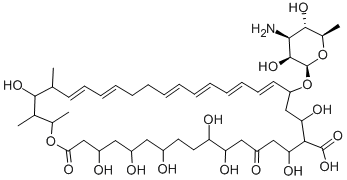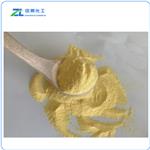
Nystatin
- Product NameNystatin
- CAS1400-61-9
- CBNumberCB0463474
- MFC47H75NO17
- MW926.09
- EINECS215-749-0
- MDL NumberMFCD27989284
- MOL File1400-61-9.mol
- MSDS FileSDS
Chemical Properties
| Melting point | >155°C (dec.) |
| alpha | D25 -10° (glacial acetic acid); +21° (pyridine); +12° (DMF); -7° (0.1N HCl in methanol) |
| storage temp. | -20°C |
| solubility | H2O: insoluble |
| pka | pKa 5.72(MeOH/2-methoxyethanol/ H2O) (Uncertain);8.64 (Uncertain) |
| form | suspension |
| color | yellow |
| Odor | ofcereals odor |
| biological source | Streptomyces noursei |
| Water Solubility | 0.36g/L(24 ºC) |
| Merck | 13,6770 |
| Specific Activity | ≥4,400USP units/mg |
| BCS Class | 3 |
| InChIKey | VXWFKTGGEJLHPP-OQMKPJEFSA-N |
| CAS DataBase Reference | 1400-61-9 |
| FDA 21 CFR | 556.470; 558.430; 310.545; 558.4 |
| EWG's Food Scores | 1 |
| NCI Dictionary of Cancer Terms | Mycostatin; nystatin |
Safety
| Symbol(GHS) |
  
|
| Signal word | Warning |
| Hazard statements | H225-H311-H331-H370 |
| Precautionary statements | P210-P260-P280-P303+P361+P353-P405-P501a |
| Hazard Codes | F,C |
| Risk Statements | 11-34 |
| Safety Statements | 22-24/25-45-36/37/39-26-16 |
| WGK Germany | 3 |
| RTECS | RF5950000 |
| F | 10-8-23 |
| HazardClass | 3 |
| HS Code | 38210000 |
| Hazardous Substances Data | 1400-61-9(Hazardous Substances Data) |
| Toxicity | LD50 i.p. in mice: ~200 mg/kg (Seneca) |


